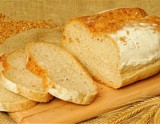19/04/2013
BREAD: GET TO KNOW IT BETTER

Wholewheat, white, yellow, with aniseed, from wheat, barley or corn, made with yeast or sourdough…Since antiquity and all the way until this day, bread haw been the cornerstone of people’s everyday nutrition. Let’s find out more about it then.
Rich in nutrients
Like every other product that contains starch(rice, wheats, pulses, potatoes and pasta) bread is one of the most basic sources of complex carbohydrates. It contains on average 55 mg of starch per 100 gr. Complex carbohydrates offer our body the energy it needs to function properly and help upkeep normal blood glucose levels.
Some bread types(mostly wholewheat) are rich in fibres, which help proper bowel function among others. Also, bread contains protein, which has low biological value, as well as a very small quantity of fat, which rises only in breads that contain oil or seeds, such as sesame. In addition, it provides us with B vitamins(thiamine-B1, riboflavin-B2, niacin-B3, folic acid-B9), which are necessary for metabolising proteins and cell proliferation, as well as the proper function of the nervous system and our skin health.
It also contains small amounts of vitamin E, which acts as a powerful antacid and antithrombotic and also helps significantly with fertility. Finally, bread is a great source of minerals and trace elements, such as iron(which is necessary for cellular growth and oxygenation), potassium(which regulates cellular function), calcium(which keeps our skeleton healthy) and selenium(a strong antacid).
It doesn’t add weight
Like all food, bread will add a few kilos if you eat much more than you should. However, despite common belief, it isn’t among the most fattening foods. When consumed within a healthy and balanced diet, it causes no problem. In reality, all bread types contain pretty much the same amount of calories. One slice(approximately 30 gr) of any bread will offer 80 calories. Only when the bread is created with seeds, sesame and nuts do its calorie levels rise.
How much bread should we eat?
A balanced diet is based on 50-60% of carbohydrates. For example, if a person needs 1.800 calories on a daily basis, 900 to 1.000 of them need to come from carbohydrates. A healthy person receiving carbohydrates from other sources as well, can eat 2 slices(about 30 gr each) of wholewheat bread per day. Nearly the same is alloted to domeone on a diet. Children, athletes and elderly people, who have higher nutritional needs, are able to eat 4 to 5 slices of wholewheat brea, always assuming that the rest of their diet is balanced.
Source: www.vita.gr
 Follow
Follow
ΣΧΟΛΙΑΣΤΕ